Commentary: Reducing inequality, cracking wealth concentration in Indonesia
The richest 10 percent of Indonesians owned an estimated 77 percent of all the country’s wealth.
Change Size
 A farmer takes care of his Bligon tobacco trees. The farmer needs to remove rotten leaves to maintain the plants. (JP/Aditya Sagita)
A farmer takes care of his Bligon tobacco trees. The farmer needs to remove rotten leaves to maintain the plants. (JP/Aditya Sagita)
T
wo major meetings held here separately last week coincidentally chose poverty, economic/income inequality and their concomitant aspects as the main themes of discussion.
One was the two-day international responsible business forum on food and agriculture, opened by Coordinating Economic Affairs Minister Darmin Nasution on Tuesday, where about 400 business leaders, officials, civil society organizations and analysts from around the world discussed programs to enhance corporate-farmer partnerships to improve agricultural value chains.
The other was the launch of the World Bank’s (WB) first Indonesia Economic Quarterly report for 2018 entitled “Towards inclusive growth” featuring a keynote speech by Finance Minister Sri Mulyani Indrawati.
In the runup to the 2014 legislative and presidential elections, economic inequality and wealth concentration were a hot, major public issue and a key theme in political campaigns.
Public opinion surveys, including a very comprehensive, methodical one conducted by the WB in 2014 in cooperation with the Indonesian Survey Institute (LSI), concluded that most respondents thought inequality in Indonesia had gotten too high and that the government should act immediately to reduce it.
Likewise, in the runup to the local elections in 171 regions in June and the legislative and presidential elections in April 2019, inequality and highly concentrated asset ownership have also increasingly become hot issues.
Unsurprisingly political leaders of the opposition parties who seem so obsessed about making the current government look so bad and pathetic often resort to sweeping accusations instead of constructive policy debates.
Nevertheless, the blunt fact is that both income inequality and wealth concentration in the country have been worrisome, especially set against the painful fact that Indonesia is still one of the world’s most corrupt countries as a result of rent-seeking and corrupt behavior by many officials and politicians.
We don’t have a more recent, comprehensive survey on both issues, except the one made by the WB in 2014, published in December 2015. The public, meanwhile, could get only a glimpse of the economic inequality from Forbes magazine’s annual list of 100 hundred richest Indonesians.
The 2015 WB report essentially warned of the risks of social tension and conflict as inequality of income and asset ownership widened, recommending a more vigorous collection of taxes to broaden the taxpayer base.
Among the findings of the WB survey were that most respondents said they thought inequality was too high and they were willing to accept slower economic growth in exchange for less inequality. Furthermore, sustained economic growth in the last 15 years to 2014 had mainly benefitted the richest 20 percent and left behind the remaining 80 percent of the country’s 250 million people.
The richest 10 percent of Indonesians owned an estimated 77 percent of all the country’s wealth. In fact, the richest 1 percent owned half of all the country’s wealth, which was the second-highest level (along with Thailand) after Russia from a set of 38 countries. This meant that income from financial and physical assets benefits fewer households in Indonesia than in many other countries. The share of wealth owned by the richest 10 percent in Indonesia increased by 7 percentage points between 2007 and 2014, in the top of 46 countries over that period.
We have become all too familiar with the main drivers of the widening inequality: Inequality of opportunity and in the labor market, massive tax evasion, high wealth concentration and unequal resilience to economic shocks.
Most analysts agree Indonesia’s narrow base of personal income taxpayers is among the main drivers of inequality, as personal income tax currently account for only around 10 percent of total tax receipts.
Worse, the structure of personal (individual) income tax is also lopsided in favor of the upper middle income and richest taxpayers as the highest rate (30 percent) is applied to annual incomes of over of Rp 500 million (US$36,500) and more, but those who earn Rp 250 million are already subject to the 25 percent tax rate.
The March, 2018 WB report therefore strongly urges the government to collect more tax revenue through an overall reform of the tax system and to spend better on priority sectors such as health, education, social assistance and rural and urban infrastructure. These measures are precisely what the Jokowi government has been doing since 2015.
More than 10 million farmers have benefitted from the easier land-titling program and millions more farmers have been given access to forest resources through the social forestry program. The rate of absolute poverty has decreased from almost 11.6 percent in 2014 to 10.12 percent, and inequality, as measured by the Gini ratio, fell from 0.42 to 0.39 and is targeted to further decline to 0.36 (0 represents perfect quality).
But these achievements seem very incremental amid the magnitude of the inequality problem because the government has been able to collect only half of the potential tax. The institutional capacity of line ministries at central government and of regional administrations is also utterly inadequate.
It is encouraging, though, that more business leaders have realized the urgent need to reduce inequality by empowering farmers not as a measure of charity but through mutually beneficial, market-driven partnership initiatives.
Franky Widjaja, chairman of the widely diversified Sinarmas group, speaking at the international responsible business forum on food and agriculture last week, reiterated the urgent need for expanding corporate-smallholder engagement.
Widjaja called for accelerated partnership arrangements between big plantation companies and smallholders so that farmers can have a better access to technical, marketing and financial assistance. He has been campaigning since 2011 for a sort of nucleus estate and smallholder (NES) scheme whereby big estates serve as the development agent providing technical and marketing assistance to improve the productivity of neighboring farmers or smallholders.
It’s high time therefore for the government to fully enforce the 2014 Plantation Law, which, among others, requires big companies to allocate a minimum 20 percent of their total plantation areas to smallholders through bank loan financing, processing and marketing cooperation arrangements.









